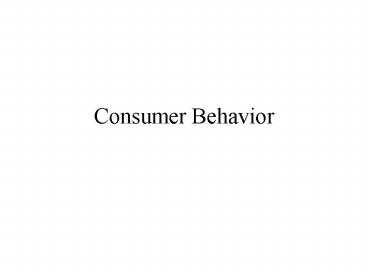Consumer Behavior - PowerPoint PPT Presentation
1 / 18
Title:
Consumer Behavior
Description:
What assumptions about behavior underlie the Indifference Curve? ... in preferences: If A is preferred to B and B preferred to C, then A is preferred ... – PowerPoint PPT presentation
Number of Views:61
Avg rating:3.0/5.0
Title: Consumer Behavior
1
Consumer Behavior
2
The Theory of Consumer Behavior
- Basic Conditions
- A World of Scarcity
- Rational Individuals with Well Defined
Preferences - Well Defined Constraints
- Translating Preferences into a Diagram --
- Indifference Curves
- What assumptions about behavior underlie the
Indifference Curve? - What does this imply about the curve? What does
it look like?
3
Properties of Indifference Curves
- Ranking
- All possible combinations of goods are possible
- Implication for Indifference Curve Curves fill
up the consumption space - Transitivity
- Consistency in preferences If A is preferred to
B and B preferred to C, then A is preferred to C - Implication for Indifference Curve Indifference
Curves do not cross - Nonsatiation
- More is preferred to less
- Implication for Indifference Curve Indifference
Curves are negatively sloped - Convexity (to the origin)
- Diminishing Marginal Utility of consumption
- Implication for Indifference Curve slope
declines as quantity increases
4
Indifference Curves
Good Y
Good X
5
The Budget Constraint
Good Y
Unattainable
Attainable
Good X
6
Changing the Budget Constraint Changing Income
Good Y
A
A
B
B
Good X
7
Changing the Budget Constraint Changing a Price
A
Good Y
B
B
Good X
8
The Basics of Indifference Curve Analysis
- Characteristics of
- Indifference Curves
- The Budget LIne
- Optimization Behavior
- Utility Maximization Making yourself as well
off as possible - What does this mean in the Indifference Curve
Framework? - Consumer Equilibrium
- MRS Relative Price Ratio (-P1/P2)
- Changes in the Consumer Equilibrium
- Income Changes
- Price Changes
- Substitution and Income Effects
9
Consumer Equilibrium
Good Y
E
Good X
10
Showing a Price Change
Good Y
E
Good X
11
Showing a Price Change
Good Y
E
E
Good X
12
Income and Substitution Effects
Good Y
G
E
E
Good X
13
Illustrating the Use of Indifference Curve
Analysis
- Problem
- Suppose that Fred buys (only) turnips and tea,
and that Fred has 20 per week to spend on these
items. The price of turnips is 2 per bunch and
tea costs 5 per box. - Draw and explain the indifference curve and
budget line that illustrates a consumer
equilibrium for Fred. - Questions
- What is the value of the MRS for Fred at
equilibrium? (Be consistent with your diagram) - Now consider what happens when the government
taxes tea at a rate sufficient to lead to a tax
of 3 per box. What happens to the consumer
equilibrium? Does this change if turnips are an
inferior good?
14
Illustrating the Problem
- The budget line illustrates Freds
consumption space. Since he has 20 spend, his
budget constraint is 2Turnips 5Tea 20.
At the equilibrium, the MRS must equal the
relative price ratio. In this case, the relative
price ratio is -Ptea/Pturnips or -5/2 or -2.5.
This is the value of the MRS at point E, the
consumer equilibrium.
15
Taxing Tea
The diagram below show the impact on Fred when
tea is taxed. Instead of being able to buy 4
boxes of tea per week, he can only buy 2.5 boxes
a week (or 5 boxes every two weeks if half boxes
are not sold). Fred decreases his consumption of
tea and increased turnip consumption
- The diagram cannot show what kind of goods tea
and turnips are since we only have a price change
and not an income change. We need to resort to a
decomposition of the price change to show this.
16
Substitution and Income Effects
- This shows the decomposition of the price change.
Note that the dashed budget line is an
artificial construct, which is parallel to the
after tax budget line facing Fred, but on the
original indifference curve. The tax changes
relative prices, shown by the change from the
original budget line to the dashed line. The
Substitution effect is the change from E1 to E3
on I0.
17
Substitution and Income Effects (cont.)
- The income effect can be shown by the shift
(inward) of the budget line to the lower line
which allows Fred to by 2.5 boxes of tea. The
Income effect is the move from E3 to E2. Both
goods are shown as normal goods, since the
consumption of both fell when income went down.
Turnips can be seen as an inferior good if the
new consumer equilibrium were at point E4.
18
Demand Curves
- Deriving Demand Curves from Indifference Curves
- Law of Demand
- Ceteris Paribus Assumption
- Shifts in Demand Curves
- A Change in Demand
- Movements along a Demand Curve
- A Change in Quantity Demanded
- Elasticity
- Price
- Income
- Cross Price
- Market Demand Curves
- Consumer Surplus































